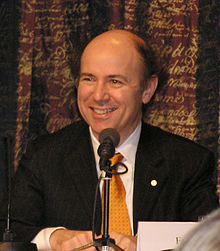Frank Wilczek
Frank Anthony Wilczek (born May 15, 1951 in Queens , New York City ) is an American physicist and winner of the 2004 Nobel Prize in Physics .
career
The son of an Italian mother and a Polish father attended school in his native Queens. He received a Bachelor of Science degree in mathematics from the University of Chicago in 1970, a Masters of Arts degree in mathematics in 1972 and a PhD in physics from Princeton University in 1974 with a thesis on Non-Abelian Gauge Theories and Asymptotic Freedom . From 1974 to 1981 and from 1989 to 2000 he was a professor at Princeton University, interrupted by research work at the Institute for Advanced Study also in Princeton in 1976/77 with a Sloan Research Fellowship . From 1980 to 1988 Wilczek was a professor at the University of California, Santa Barbara and a member of the Kavli Institute for Theoretical Physics . Since 2000 he has been the Herman Feshbach Professor of Physics at the Massachusetts Institute of Technology .
Achievements and awards
1973, during his time as a doctoral student at Princeton, Frank Wilczek discovered along with David Gross , the asymptotic freedom . It says that the closer they are to each other, the weaker the strong interaction between quarks . If two quarks are extremely close together, the interaction is so weak that they behave almost like free particles. This theory, which was also discovered independently by David Politzer , was an important step in the development of quantum chromodynamics .
Wilczek introduced the Axion and later dealt intensively with anyons, among other things .
In 2012 he proposed the concept of a “ time crystal ”, a new state of matter that exhibits periodic oscillations in its ground state. This was rejected as impossible by specialist colleagues. In 2017, states were detected in externally excited quantum systems, the frequency of which deviated from the excitation frequency. In analogy to Wilczek's idea, such states were called “discrete time crystals”.
In 1982 he was a MacArthur Fellow . In 1994 Wilczek was awarded the Dirac Medal (ICTP) , in 2003 the Julius Edgar Lilienfeld Prize of the American Physical Society , and in 2004 he and David Gross and David Politzer received the Nobel Prize in Physics for the discovery of asymptotic freedom in the theory of strong interaction . In 2005 he received the König Faisal Prize , in 2003 the High Energy and Particle Physics Prize of the EPS and in 2008 the Julius Wess Prize of the Karlsruhe Institute of Technology . In 2013 he was awarded the Oskar Klein Medal .
He is also an elected member or fellow of the National Academy of Sciences (1990), the American Academy of Arts and Sciences (1993), the American Association for the Advancement of Science (2000), the American Physical Society and the American Philosophical Society ( 2005). He is an external member of the Polish Academy of Learning in Cracow .
Fonts
- Frank Wilczek: Lightness of being: mass, ether, and the unification of forces. Basic books, New York 2008, ISBN 978-0-465-00321-1 .
- Frank Wilczek: Fantastic realities: 49 mind journeys and a trip to Stockholm. With a contrib. from Betsy Devine. World Scientific, Singapore 2006, ISBN 981-256-649-X .
- Frank Wilczek and Betsy Devine: Longing for the harmonies: themes and variations from modern physics. Norton, New York 1988, ISBN 0-393-02482-2 .
- Frank Wilczek: A Beautiful Question. Penguin, New York 2015
Web links
- Information from the Nobel Foundation on the 2004 award ceremony for Frank Wilczek
- Nobel lecture by Frank Wilczek (Dec. 2004): Asymptotic freedom: From paradox to paradigm , PNAS vol. 102 no. 24 8403-8413, June 14, 2005 - Full Text (PDF; 1.0 MB)
- Publications by Frank Wilczek at SPIRES
- Frank Wilczek . In: arXiv.org
- Frank Wilczek's homepage at MIT
- List of publications by Wilczek (PDF; 156 kB)
- Blog about the Nobel adventures of the Wilczek family (English)
- Physics Today publications by Frank Wilczek
- Frank Wilczek: The Persistence of Ether . In: Physics Today . tape 52 , no. 1 , January 1999, p. 11–13 , doi : 10.1063 / 1.882562 ( mit.edu [PDF; accessed on February 10, 2018]).
- Frank Wilczek in the Mathematics Genealogy Project (English)
Individual evidence
- ↑ Mike Beckers: Time Crystals - bizarre matter in endless oscillation. In: Spektrum.de. March 8, 2017, accessed on August 2, 2017 (Note: See also → en: Time crystal ).
- ↑ "The world is a work of art" . In: Der Spiegel . No. 33 , 2015, p. 104–106 ( online - August 8, 2015 , Spiegel interview with Frank Wilczek).
| personal data | |
|---|---|
| SURNAME | Wilczek, Frank |
| ALTERNATIVE NAMES | Wilczek, Frank Anthony (full name) |
| BRIEF DESCRIPTION | American physicist and 2004 Nobel Laureate in Physics |
| DATE OF BIRTH | May 15, 1951 |
| PLACE OF BIRTH | New York , New York |
